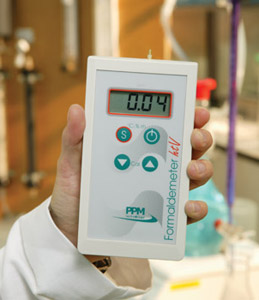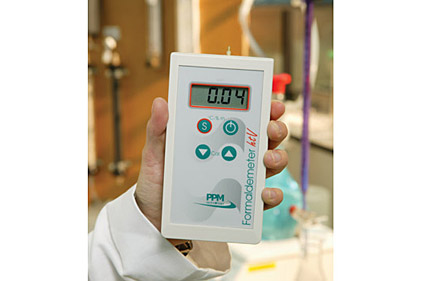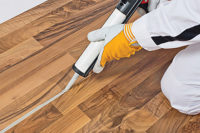Formaldehyde is a chemical widely used to manufacture building materials and various household products. Formaldehyde resin is an adhesive commonly used in woodworking, especially in veneer and lamination work. It is known for open working time, rigidity and moisture resistance.
in woodworking, especially in veneer and lamination work. It is known for open working time, rigidity and moisture resistance.
Formaldehyde resins are traditionally used in the wood panel industry. Both particleboard and medium-density fiberboard (MDF) generally use urea-formaldehyde (UF) resins. Decorative plywood and veneered composites can also use resins; these interior applications are often found in paneling, cabinets or furniture.
Off-Gassing Conditions
Anyone involved in the manufacture of any of these products could be exposed to formaldehyde in the air. Unless due care and attention is paid, formaldehyde emissions from the production of those other panels can reach dangerous levels at production lines, especially in areas such as resin preparation and use, forming and hot pressing. Ventilation in these facilities must therefore be good; it is advised to sample airborne levels of formaldehyde regularly to ensure workers aren’t at risk of overexposure.
For finished products, formaldehyde release is highest in newly manufactured pressed wood products. Experiments have demonstrated that in a stable environment (temperature and humidity), formaldehyde release does decrease over time, and the low initial values of typical particleboard and MDF panels will decrease by at least 50% within a few weeks of manufacture.
Formaldehyde can be released as a vapor due to off-gassing from products containing formaldehyde-based resins. Conditions of high humidity, heating or agitation (including sawing or grinding) of formaldehyde-based products can lead to increased levels of formaldehyde in the air. Workers may be exposed by breathing in the fumes from formaldehyde products as a result of off-gassing from unsealed or freshly cut surfaces and the associated dust particles.
Health Effects
Formaldehyde is highly toxic to humans, regardless of the intake method. Even short-term exposure to formaldehyde irritates the eyes, causing pain, redness, blurred vision and severe watering. It can irritate the nose and throat, causing sneezing, soreness, coughing, shortness of breath, headaches, and nausea.
Exposure to elevated levels can lead to the accumulation of fluid in the lungs (pulmonary edema). A large exposure to formaldehyde is converted to formic acid in the body, leading to a rise in blood acidity, rapid or shallow breathing, hypothermia, and coma or death. Long-term exposure causes chronically impaired lung function, skin hardening, swelling and flaking, dermatitis, allergic eczema, and cancer.
Formaldehyde is a skin and respiratory sensitizer. Because it is a sensitizing agent, it can stimulate the body’s immune response so that a subsequent exposure to even a very small amount is likely to trigger an allergic response. Formaldehyde has also been shown to cause sleep disturbance, impaired memory, reduced concentration, nausea and menstrual irregularity. It is estimated that 10-20% of the U.S. population, including asthmatics, may have hyper-reactive airways, which may make them more susceptible to formaldehyde effects.
The International Agency for Research on Cancer (IARC), which is part of the World Health Organization, has designated formaldehyde as a known cause of several types of throat and nasal cancer. In June 2011, the U.S. National Toxicology Program has described formaldehyde as “known to be a human carcinogen.” The report prepared for the Secretary of the Department of Health and Human Services (HHS) contained warnings from scientists that people with higher exposure to formaldehyde are more at risk for nasopharyngeal cancer, myeloid leukemia and other forms of cancers.
Exposure Levels
In the UK, formaldehyde has been assigned a maximum exposure limit (MEL) of two parts per million (ppm). In the U.S., the Occupational Safety and Health Administration (OSHA) has set a permissible exposure level of 0.75 ppm. In Sweden and Germany, the maximum permissible indoor level is 0.1 ppm. Many other nations have similar exposure level regulations in place.
Safety and Detection
In buildings and facilities where formaldehyde is used, it is important that formaldehyde levels are regularly monitored. In order to ensure employees are not exposed to dangerous concentrations of formaldehyde in the air, it is advisable to detect and monitor levels with a suitable detection instrument. Real-time results mean that potential overexposures can be identified as they occur, without the delay of laboratory analysis. If a dangerous level is detected, employees can be evacuated until the risk is reduced.
The latest formaldehyde detection and measurement instrumentation is able to accurately detect and monitor formaldehyde, temperature and humidity in real time.* Units can be used as manual, hand-held instruments or as continuous monitoring devices capable of up to one month of data-logging. When used in a manual, hand-held capacity, the instrumentation can take instantaneous single-point measurements of formaldehyde, temperature and humidity. Some units can precisely measure formaldehyde concentrations in parts per million and mg/m3 over a wide range of temperature and humidity, while built-in memory and real-time clocks enable the logging of all three parameters and corresponding times to provide improved monitoring and analysis opportunities.
For more information, email info@ppm-technology.com or visit www.ppm-technology.com.


